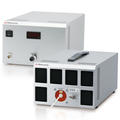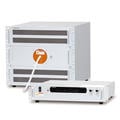Selection chart of High Voltage Amplifiers
High Voltage Amplifiers
Models with the fastest slew rate of 1,200 V/µs or compact modules for built-in use are available. Those series produce high voltage output in sine waves, triangle waves, sawtooth waves, square waves, and more.
| Series |
AP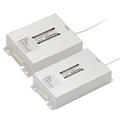
|
AS
|
COR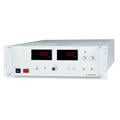
|
AMS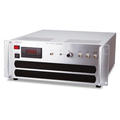
|
AMJ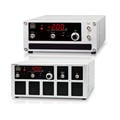
|
AMT
|
AMP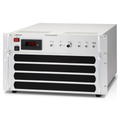
|
AMPS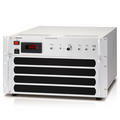
|
|
|---|---|---|---|---|---|---|---|---|---|
| Output Power | 3 to 10 W | 3 to 10 W | 20 W | ±20 to ±200 W | 20 to 40 W | ±20 to ±200 W | 0.1 to 1.2 kW | 0.4 to 1.2 kW | |
| Frequency bandwidth (-3 dB) * It differs from the model conditions. |
DC to 2 kHz | DC to 24 kHz | DC to 1 kHz | DC to 30 kHz | DC to 75 kHz | DC to 100 kHz | DC to 60 kHz | DC to 200 kHz | |
| Output Voltage | 0.3 kV | ±0.3 kV | ±0.3 kV | ||||||
| 0.5 kV | ±0.5 kV | ||||||||
| 0.6 kV | ±0.6 kV | ±0.6 kV | ±0.6 kV | ±0.6 kV | ±0.6 kV | ||||
| 1 kV | ±1 kV | ±1 kV | ±1 kV | ±1 kV | ±1 kV | ||||
| 1.5 kV | ±1.5 kV | ±1.5 kV | ±1.5 kV | ||||||
| 2 kV | ±2 kV | ±2 kV | ±2 kV | ||||||
| 3 kV | ±3 kV | ±3 kV | ±3 kV | ||||||
| 4 kV | ±4 kV | ||||||||
| 5 kV | ±5 kV | ±5 kV | ±5 kV | ±5 kV | |||||
| 10 kV | ±10 kV | ±10 kV | ±10 kV | ±10 kV | ±10 kV | ||||
| 20 kV | ±20 kV | ±20 kV | |||||||
| 30 kV | ±30 kV | ±30 kV | |||||||
| 40 kV | ±40 kV | ||||||||
| Features | Slew rate | Fast responsivity up to 24 kHz | Fast response of slew rate up to 30 V/µs | Ultra high slew rate up to 1200 V/µs, only ±10 kV output model and ±20 kV output model | |||||
| High speed response | High-speed response up to 75 kHz | High speed response 360V/µ sec | High-speed response of slew rate up to 700 V/µs | High-speed response of frequency bandwidth up to 100 kHz | |||||
| Wave form | Desired output waveform reference to the input waveform. | Desired output waveform reference to the input waveform. | Various types of output waveforms according to the input wave | Various types of output waveforms | Various types of output waveforms according to the input wave | ||||
| DC bias function | DC bias function | DC bias function | DC bias function | ||||||
| DC output voltage monitor | DC output voltage monitor, 3.5-digit digital meter | DC output voltage monitor, 3.5-digit digital meter | DC output voltage monitor, 3.5-digit digital meter | ||||||
| Other | All-Solid-State | All-Solid-State | Three functions of CC, CV, and HV amplifier in one unit | The demand for evaluation of higher voltage solar panel | |||||
| Return current terminal is standard and best for corona current control | |||||||||
| Ripple | 0.025% rms or less | 0.025% rms or less | 0.1% p-p or less | 0.1% p-p or less | Less than 0.1% | 0.02% + 1 Vp-p or less | Less than 0.02% + 1 Vp-p | Less than 0.02% + 0.5 Vp-p | |
| Applications | Electro photography process | Electro photography process | Electro photography process | Research and Development of electrophotographic process | Electro photography process | Electro photography process | Electro photography process | Electro photography process | Electro photography process |
| Corona discharge | Corona discharge | Corona discharge | Experiment of corona discharge | Corona discharge | Corona discharge | Corona discharge | Corona discharge | ||
| Beam deflection | Beam deflection | Beam deflection | Beam deflection | Beam deflection | Beam deflection | Beam deflection | Beam deflection | ||
| Electrorheological fluid | Electrorheological fluid | Electrorheological fluid | Electrorheological fluid | Electrorheological fluid | Electrorheological fluid | Electrorheological fluid | |||
| Electrostatic chuck | Electrostatic chuck | Electrostatic chuck | Electrostatic chuck | Electrostatic chuck | Electrostatic chuck | Electrostatic chuck | |||
| Various Electrostatic tests | Various Electrostatic tests | Various Electrostatic tests | Various Electrostatic tests | Various Electrostatic tests | Various Electrostatic tests | Various Electrostatic tests | Various Electrostatic tests | ||
| Other test | Insulation and breakdown voltage testing | Insulation and breakdown voltage testing | Photosensitive drum testing | Breakdown voltage testing | Breakdown voltage testing | Breakdown voltage testing | Breakdown voltage testing | ||
| Series |
AP |
AS |
COR |
AMS |
AMJ |
AMT |
AMP |
AMPS |
|
High Voltage Pulse Power Supplies
The below pulse power supplies are ideal for ion beam deflection, synchrotron radiation measurement, PMT and MCP.
What is a Bipolar Power Supply? (Basic Knowledge)
High Voltage Amplifier
High voltage amplifier converts the input voltage to high voltage waveform as it is as shown in Fig. 1. These days, the demand for HV amplifiers is growing more and more, and now becoming an indispensable tool for research and development, experiments and integrating to a system for such fields as electronics, physics, biochemical and medical industries. With high-voltage technologies, Matsusada Precision Inc. manufactures various high-voltage amplifiers to meet all customers' requirements.
* We have amplifiers developed especially for electrostatic chuck or PZT. Please ask for details to our sales staff.
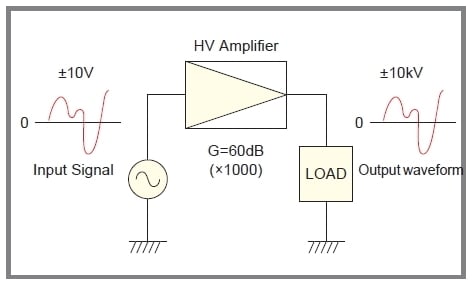
Four-quadrant Output Range
High Voltage amplifier is generally equipped with the "sink" function for output currents that provides constant voltage operation without regard to the type of load, whether it is capacitive or conductive. (Fig.2) As it gives a fast response, it is an ideal power supply for applications that require AC output.
Matsusada High Voltage amplifiers are all bipolar type and can be operated in a full four-quadrant area. (I, II, III, IV area)
- Vomax: Rated output voltage
- Iomax: Rated output current

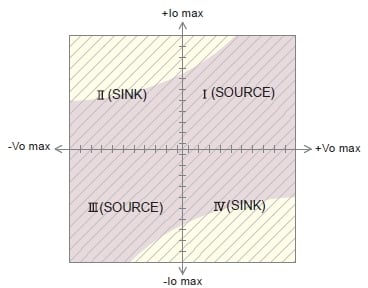
Slew Rate
The responsivity of our high-speed amplifier is determined by slew rate (SR). The step responsivity of our amplifier is shown in Fig. 3.
SR = ΔV/μS
In case the output amplitude is smaller, the response time becomes shorter. AMP series reach to greater than SR =700 V/µS at maximum.
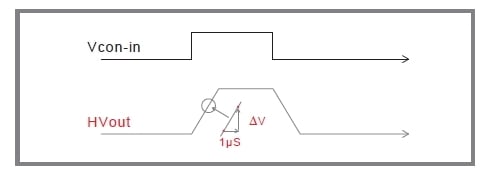
Rise Time (step response)
Step response can be indicated with rise time. (fig.4) Usually, the rise time of the amplifier of response (= bandwidth) fc (Hz) is given in the formula below.
tr ≒ 0.35/fc.
The fall time tf is equal to tr.
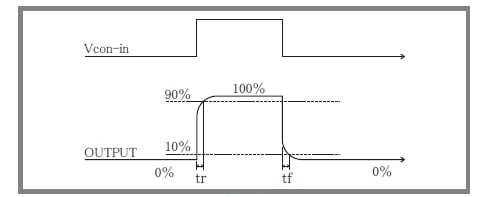
Frequency Response
Response of Matsusada amplifiers is described as "frequency bandwidth". When swinging the output with a sinusoidal waveform with rated resistive load, output swing (amplitude) is reduced as input frequency becomes faster. The frequency response in the specification is the frequency fc, where the output swing is 70% (-3 dB). (Fig. 5)
In case a clear output waveform is required, please select a High Voltage amplifier that has high enough frequency bandwidth against the required frequency. In general, three to five times more frequency bandwidth is required for the sinusoidal waveform and about 10 times more for the rectangular waveform. In case of insufficient frequency bandwidth, the output swing shall be reduced, and also the phase difference will be large, so some solutions, such as monitoring output waveform, shall be required.
* Please avoid continuous inputting of a high-frequency signal, which reduces the output frequency of an amplifier. An amplifier will be broken because of an increase in internal loss.
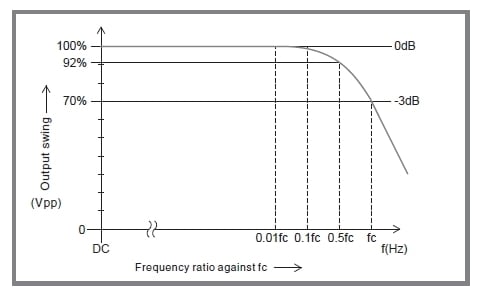
Capacitive Load
When a capacitive load is more than 100 pF (including a stray capacitance of output wire), the resonance in the output may occur. In that case, install 100 Ω (at 0.1 μF) to 1000 Ω (at 1000 pF) of high-voltage resistance in the output in series. Please note that the frequency band is limited when using an amplifier with a capacitive load, as shown in the formula on the right.
In addition, when an amplifier is used for a corona discharge, a current higher than its rating will flow, and it will affect the amplifier badly. In this case, as well as when using an amplifier with a capacitive load, please install the output resistance and limit the current.
* Please avoid continuous input of the high-frequency signal, which reduces the output frequency of an amplifier. An amplifier will break because of an increase in internal loss.
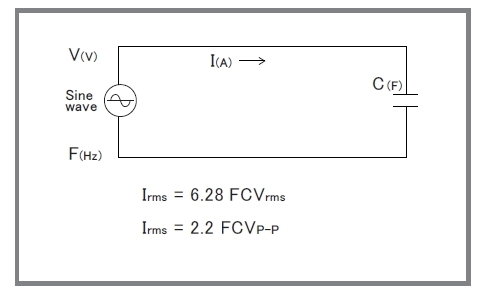
Important note to utilize the full performance of high-speed High Voltage amplifier
Output cable of High Voltage amplifiers is not shielded. Suppose the output cable has some stray capacity against the ground (earth ground or metal objects). In that case, the output voltage will be sinusoidal or stop waveform, and extra current will be drawn. As this current draws parallel to the load, the following appearance might be happened.
- Slew rate or response frequency drop
- The waveform is distorted or changed
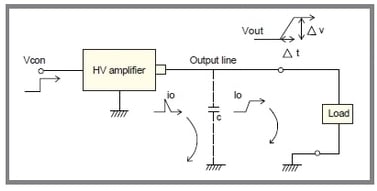
When there is output stray capacitance C, the leak current by C will be as below.

Solution
Make sure to have proper connection to make stray capacitance of High Voltage cable as low as possible.
- Keep the length of the output cable as short as possible.
- Keep the output cable away from floor, desks, or metal objects.
- Have no shielding on the output cable.




